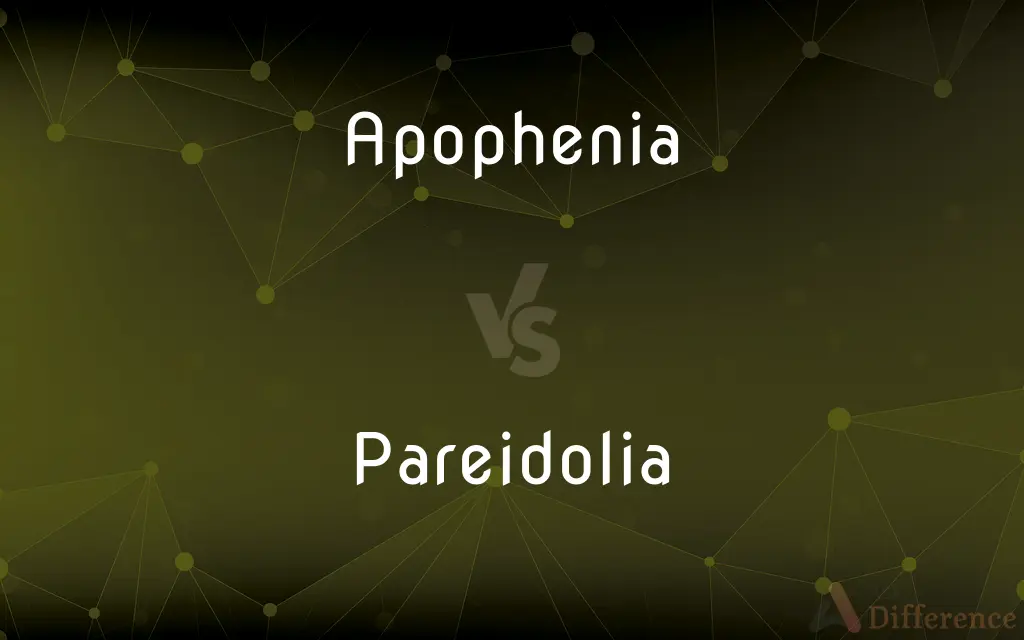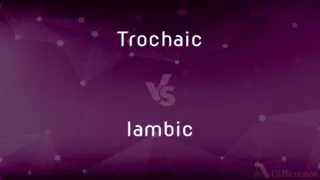Apophenia vs. Pareidolia — What's the Difference?
Edited by Tayyaba Rehman — By Urooj Arif — Updated on May 3, 2024
Apophenia involves seeing patterns in random data, while pareidolia specifically refers to recognizing faces or familiar shapes in stimuli.

Difference Between Apophenia and Pareidolia
Table of Contents
ADVERTISEMENT
Key Differences
Apophenia is the tendency to perceive meaningful connections between unrelated things, which can occur in various contexts such as gambling or conspiracy theories. Whereas pareidolia is a type of apophenia that specifically involves seeing patterns like faces in objects, clouds, or nature.
In apophenia, patterns might be perceived in random numbers or events, suggesting a significant correlation where none exists. On the other hand, pareidolia often results in the interpretation of visual stimuli as significant, such as seeing a face on the moon.
Apophenia can manifest in sensory experiences but is often more abstract, such as linking ideas or events in a meaningful way. Whereas pareidolia is primarily a visual phenomenon where the interpretations are specifically images of animate objects or faces.
Researchers study apophenia in fields like psychology and behavioral economics to understand cognitive biases. In contrast, pareidolia is frequently discussed in the context of social and cultural phenomena, such as religious apparitions or folklore.
Apophenia may lead to beliefs in pseudoscience or superstitions, as individuals assert unwarranted connections between events. Conversely, pareidolia usually provides amusement or artistic inspiration rather than profound belief systems.
ADVERTISEMENT
Comparison Chart
Definition
Perceiving patterns in random data.
Seeing specific patterns, like faces.
Contexts of Occurrence
Gambling, conspiracy theories.
Visual stimuli like clouds, objects.
Types of Stimuli
Numbers, events, ideas.
Visual images, often faces.
Common Outcomes
Pseudoscience beliefs, superstitions.
Amusement, artistic inspiration.
Research Fields
Psychology, behavioral economics.
Cultural studies, psychology.
Compare with Definitions
Apophenia
Often related to belief in paranormal or conspiracy theories due to pattern recognition.
Believing that major world events are connected by hidden clues is an apophenic perception.
Pareidolia
A common psychological phenomenon involving visual misperceptions.
Imagining that the moon has eyes and a mouth involves pareidolia.
Apophenia
The tendency to mistakenly perceive connections and meaning between unrelated things.
Seeing a winning streak in gambling as skill, not luck, is often due to apophenia.
Pareidolia
The tendency to see faces in everyday objects or textures.
Seeing a face in the knots of a tree trunk is an instance of pareidolia.
Apophenia
The identification of patterns or connections in random or meaningless data.
Claiming that winning numbers in a lottery are influenced by previous draws exemplifies apophenia.
Pareidolia
Typically harmless, offering a playful aspect to human perception.
Enjoying cloud shapes that resemble animals is a fun example of pareidolia.
Apophenia
Psychologically, it represents a cognitive bias towards finding patterns.
Investors might see patterns in stock market movements that are actually random, a common case of apophenia.
Pareidolia
Often evokes emotional responses based on the perceived images.
Feeling comforted by seeing a smiling face in household objects is due to pareidolia.
Apophenia
Can manifest as numerology in cultures, finding meaningful connections in numbers.
Apophenia is at work when someone attributes personal significance to specific numbers.
Pareidolia
Can lead to artistic creativity or entertainment.
Artists may use pareidolia to create engaging and imaginative artworks.
Apophenia
Apophenia () is the tendency to perceive meaningful connections between unrelated things. The term (German: Apophänie from the Greek verb ἀποφαίνειν (apophaínein)) was coined by psychiatrist Klaus Conrad in his 1958 publication on the beginning stages of schizophrenia.
Pareidolia
Pareidolia (; also US: ) is the tendency for perception to impose a meaningful interpretation on a nebulous stimulus, usually visual, so that one sees an object, pattern, or meaning where there is none. Common examples are perceived images of animals, faces, or objects in cloud formations, seeing faces in inanimate objects, or lunar pareidolia like the Man in the Moon or the Moon rabbit.
Apophenia
(psychology) The perception of or belief in connectedness among unrelated phenomena.
Pareidolia
The perception of a recognizable image or meaningful pattern where none exists or is intended, as the perception of a face in the surface features of the moon.
Pareidolia
(psychology) The tendency to interpret a vague stimulus as something known to the observer, such as interpreting marks on Mars as canals, seeing shapes in clouds, or hearing hidden messages in music.
Common Curiosities
Can apophenia be considered a disorder?
While apophenia itself is not a disorder, excessive apophenic perceptions can be symptomatic of psychiatric conditions.
Are there any benefits to experiencing pareidolia?
Yes, experiencing pareidolia can boost creativity and provide emotional comfort through familiar images.
What is apophenia?
Apophenia is the tendency to perceive connections and meaningfulness in unrelated things.
How does pareidolia affect everyday life?
Pareidolia usually enhances creativity and amusement by letting people see familiar shapes in their surroundings.
How can one differentiate between apophenia and pareidolia?
Apophenia is a broader concept of pattern recognition, while pareidolia specifically refers to recognizing images, often faces.
What is pareidolia?
Pareidolia is the perception of faces, figures, or patterns in mundane objects or vague stimuli.
Does pareidolia indicate any psychological issues?
No, pareidolia is a normal and common psychological phenomenon.
How is apophenia studied scientifically?
Apophenia is studied in psychology and neuroscience to understand cognitive biases and error patterns.
What impact does pareidolia have on art?
Many artists utilize pareidolia to create visually intriguing works that engage and surprise viewers.
Can pareidolia be useful in any professions?
Yes, artists, designers, and writers can use pareidolia to spark creativity and generate novel ideas.
Are children more prone to pareidolia?
Yes, children, with their vivid imaginations, are particularly prone to experiencing pareidolia.
What are common examples of pareidolia?
Common examples include seeing faces in the moon, clouds, or patterns in wallpaper.
Is apophenia linked to creativity?
Yes, apophenia can enhance creativity by enabling people to make unique connections.
Why do people experience apophenia?
Apophenia may stem from the brain’s pattern recognition abilities, sometimes leading to erroneous connections.
What triggers apophenia?
Triggers include a high need for certainty or control, which leads the mind to find order in chaos.
Share Your Discovery

Previous Comparison
Adage vs. Idiom
Next Comparison
Trochaic vs. IambicAuthor Spotlight
Written by
Urooj ArifUrooj is a skilled content writer at Ask Difference, known for her exceptional ability to simplify complex topics into engaging and informative content. With a passion for research and a flair for clear, concise writing, she consistently delivers articles that resonate with our diverse audience.
Edited by
Tayyaba RehmanTayyaba Rehman is a distinguished writer, currently serving as a primary contributor to askdifference.com. As a researcher in semantics and etymology, Tayyaba's passion for the complexity of languages and their distinctions has found a perfect home on the platform. Tayyaba delves into the intricacies of language, distinguishing between commonly confused words and phrases, thereby providing clarity for readers worldwide.












































